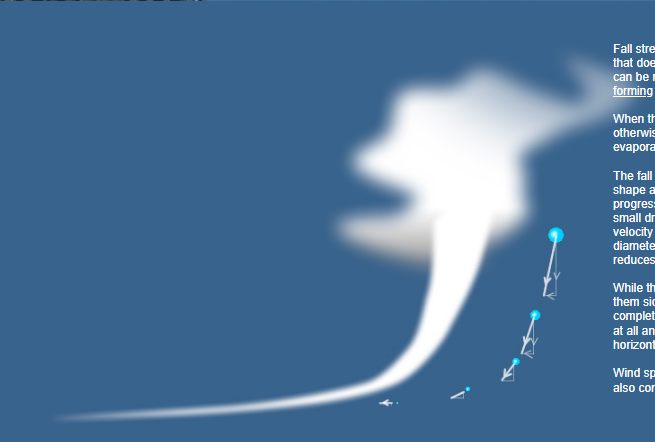Fall streaks - Virga
Fall Streaks - Virga: A Fascinating Atmospheric Phenomenon
Fall streaks, also known as virga, are a captivating atmospheric optics phenomenon that occurs when cloud precipitation does not reach the ground. These streaks can consist of raindrops, snowflakes, or even ice crystals that form halos. While fall streaks may appear as mere wisps of cloud hanging beneath a larger cloud mass, they hold a mesmerizing secret - the droplets or ice crystals are evaporating before they can touch the Earth's surface.
The reason behind the formation of fall streaks lies in the air beneath the cloud being warmer or less humid than the cloud itself. As the precipitation descends, it encounters this drier or warmer air, causing the drops or crystals to evaporate. This evaporation process is accelerated when the air is dry, leading to the streaks appearing more pronounced.
One distinguishing feature of fall streaks is their characteristic hooked shape. As the droplets or crystals shrink due to evaporation, their downward velocity decreases. In fact, for small drops in laminar flow, the downward velocity diminishes rapidly as their diameter decreases. Consequently, the wind carries these diminishing drops sideways, giving rise to the hooked shape of fall streaks. Towards the end of their journey, when the drops have almost completely evaporated, they are hardly falling at all, and the tail of the streak becomes almost horizontal.
In addition to the evaporation process, wind speed changes with height, known as shear, can also contribute to the shape of fall streaks. The varying wind speeds at different altitudes can cause the precipitation to tilt or bend, further enhancing the distinctive appearance of these phenomena.
The occurrence of fall streaks can vary depending on several factors such as the temperature and humidity profile of the atmosphere, the size and density of the precipitation particles, and the wind patterns in the region. These factors can create a range of fall streak shapes and sizes, from thin wisps to more substantial streaks that stretch across the sky.
It is worth noting that fall streaks are not limited to a specific type of cloud or weather condition. They can be observed in various cloud types, including cumulus, cumulonimbus, and altocumulus clouds. Additionally, fall streaks can be seen in different regions around the world, making them a captivating phenomenon for sky watchers everywhere.
While fall streaks may not bring precipitation to the ground, they serve as a visual reminder of the dynamic nature of the Earth's atmosphere. Their transient and ephemeral nature adds an element of beauty and intrigue to the ever-changing sky. So, the next time you spot these delicate wisps hanging beneath a cloud, take a moment to appreciate the enchanting spectacle of fall streaks - a captivating display of nature's artistic flair.
Conclusion
Fall streaks, also known as virga, are a fascinating atmospheric optics phenomenon where cloud precipitation evaporates before reaching the ground. These streaks, which can consist of raindrops, snowflakes, or ice crystals, exhibit a distinctive hooked shape due to the shrinking and evaporation of the precipitation particles. Wind speed changes with height can also contribute to the shape of fall streaks. While various factors influence their formation, fall streaks can be observed in different cloud types and regions around the world. Their ephemeral nature adds an element of beauty and wonder to the ever-changing sky, making them a captivating spectacle for sky watchers everywhere. So, keep your eyes to the sky and marvel at the mesmerizing display of fall streaks - nature's own ephemeral artwork.

Virga - Fall Streaks - Imaged near Manchester, England by Pete Burgess. ©Pete Burgess, shown with permission.

Fall streaks or virga are cloud precipitation that does not reach the ground. The streaks can be raindrops, snowflakes or even halo forming ice crystals.
When the air beneath the cloud is warmer or otherwise less humid the falling drops evaporate.
The fall streak�s characteristic hooked shape arises because drops fall progressively slower as they shrink. For small drops in laminar flow the downward velocity varies as the square of their diameter - Thus the downward velocity reduces rapidly as the drops get smaller.
While this is happening the wind carries them sideways. When the drops have almost completely evaporated they are hardly falling at all and the streak�s tail is almost horizontal.
Wind speed changes with height (shear) can also contribute to the streak�s shape.
Note: this article has been automatically converted from the old site and may not appear as intended. You can find the original article here.
Reference Atmospheric Optics
If you use any of the definitions, information, or data presented on Atmospheric Optics, please copy the link or reference below to properly credit us as the reference source. Thank you!
-
<a href="https://atoptics.co.uk/blog/fall-streaks-virga/">Fall streaks - Virga</a>
-
"Fall streaks - Virga". Atmospheric Optics. Accessed on December 22, 2024. https://atoptics.co.uk/blog/fall-streaks-virga/.
-
"Fall streaks - Virga". Atmospheric Optics, https://atoptics.co.uk/blog/fall-streaks-virga/. Accessed 22 December, 2024
-
Fall streaks - Virga. Atmospheric Optics. Retrieved from https://atoptics.co.uk/blog/fall-streaks-virga/.